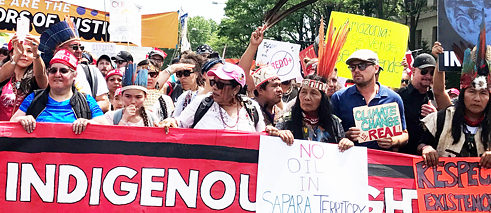Activism in Washington D.C.
The Climate March

A gathering of thousands becomes a weekly routine: 100 days into a new administration, the topic is climate injustice.
For many living in Washington, DC., activism is becoming a weekly routine. On Saturday, April 29th, thousands lined the streets of downtown Washington, DC at the People’s Climate March. Similar crowds gathered a week earlier at the March for Science.
While the March for Science was created to show commitment to science, professionals in the field, and the scientific community’s integral role in our developing world, the People’s Climate March was organized around a broader mission: empowering everyday people to stand up for social, economic, and climate justice.
The Climate March was attended by more than 200,000 people. While most were DC residents, many traveled to the nation’s capital for the occasion. Signs big and small were main attractions; artists gave away homemade prints and climate organizations passed out signs for those marching without one.
The demonstration was a family affair. Children were pushed in covered wagons and strollers masked by umbrellas to keep out the heat, holding homemade signs and sucking on popsicles. Frequently seen signs included posters with the phrase “there is no planet B.”
Elaborate floats and banners marked the front of each bloc of the march, which was broken up into different contingents of people vocalizing various issues and bringing to light their connections to the broader fight for climate justice.
This organizational strategy differentiated the event from previous demonstrations this year. The tactic allowed for visible focus on the problems caused by climate injustice that affect the lives of everyday people. Famous advocates for action on climate change were also in attendance. Leonardo DiCaprio marched with Indigenous leaders and native peoples; former Vice President Al Gore and activist Mari Copeny, known as Little Miss Flint, also marched on Saturday.
Volunteers and staff stood hand in hand circled around the blocs, creating a human bubble around the demonstrators. At the front stood the Protectors of Justice, a contingent consisting of indigenous and frontline environmental and climate justice communities. Next marched the Creators of Sanctuary: immigrants, LGBTQI, food and housing justice groups. The Builders of Democracy followed closely behind, made up of labor groups and voting rights organizations advocating for worker’s rights and voting rights to help grow and expand our democracy. The Guardians of the Future included families, youth and the elderly. Next came The Defenders of Truth, who were scientists and educators. The Keepers of Faith were composed of religious and interfaith groups, and The Reshapers of Power marched against corporations, nuclear energy and fossil fuels, and advocated for renewable energy. The Many Struggles, One Home bloc brought in the rear as activists and environmentalists marched for environmental and climate justice.
By the time the march passed 1600 Pennsylvania Avenue and filtered back around the Washington monument, the temperature reached 90 degrees. Demonstrators filled their water bottles and moved to the grass to convene before an afternoon of speakers, music, and movement building activities.
The Climate March fell on Donald Trump’s 100th day in office. Ninety-nine days after the Women’s March that prompted more than 600 protests around the world, chants were altered for the occasion. “Welcome to your first day, we will never go away” became “welcome to your 100th day, resistance is here to stay.”
The march was one of many demonstrations considered an act of resistance against the government. But the People’s Climate March was planned before Donald Trump’s election, and was organized to occur regardless of who occupied the oval office.
The first Climate March was held in 2014 to urge President Obama to act on climate change; the United States formally joined the Paris Climate Agreement the following year. President Trump has not yet made public whether the United States will remain one of the 195 countries in the agreement. Regardless of his decision, millions of people in America and across the world will continue to advocate for fossil fuel divestment and the transition to renewable sources of energy, tougher restrictions on carbon emissions, and an increase in the creation of green market jobs.
Climate injustice spans centuries, not merely the length of a presidential administration, and thus there are few reasons to believe this increased level of activism will stop being routine any time soon.